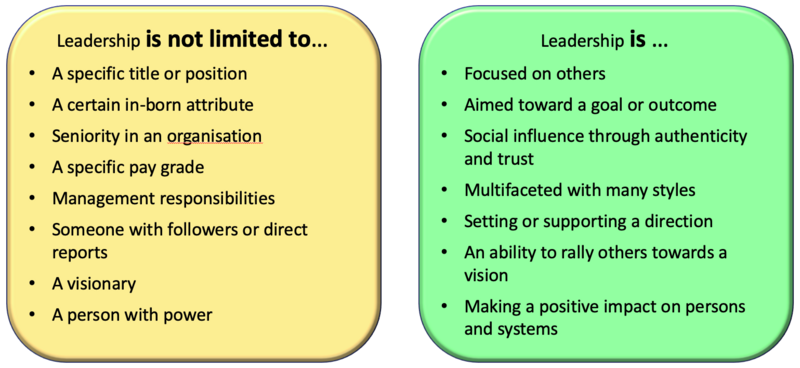Leading in Rehabilitation - Assess the Situation: Difference between revisions
No edit summary |
No edit summary |
||
| Line 13: | Line 13: | ||
Rather than being limited to an organisational position with specific responsibilities and structural power, effective leadership incorporates characteristics of | Rather than being limited to an organisational position with specific responsibilities and structural power, effective leadership incorporates characteristics of an outward focus and ability to motivate others toward a shared vision with influence gained by trust and respect. These attributes may be found or developed in a person who is a formal leader - in other words someone who has been formally appointed to a position of authority - or one who is an informal leader with the ability to influence via inspiration, engagement, and encouragement. <blockquote> | ||
'''<big>A formal leader...</big>''' | |||
* Someone formally appointed by the organisation or elected by the members to a position of authority | |||
* Someone who possesses formal authority in the organisational hierarchy | |||
* Someone who may lead by authority, influence, engagement, or a combination of these; followers may respond out of respect and admiration, or out of fear and compliance. | |||
* Examples: manager, supervisor, team captain, director, chief executive officer. | |||
</blockquote><blockquote>'''<big>An informal leader...</big>''' | |||
* Someone without formal organisational authority or power. | |||
* Someone who may possess unique skills, education, or knowledge. | |||
* Someone who is emotionally effective. | |||
* Someone who influences others by conviction, inspiration, engagement, relationship, or encouragement. | |||
* Examples: clinician, team member, anyone. | |||
</blockquote> | |||
== Situational Leadership == | == Situational Leadership == | ||
Revision as of 09:16, 31 January 2022
Original Editor - Thomas Longbottom based on the course by
Jason Giesbrecht
Top Contributors - Thomas Longbottom, Jess Bell, Kim Jackson, Jorge Rodríguez Palomino and Ewa Jaraczewska
Introduction[edit | edit source]
A gap commonly exists between knowing about leadership to doing the leading. Bridging this gap can help persons in formal and informal leadership positions become capable and influential leaders in rehabilitation. A framework for this endeavour consists of four components: assessing the situation, selecting the leadership approach, implementing the leadership approach, and then reflecting on and learning from the experience. These four components will comprise the 4-course series on leadership in rehabilitation. The first step involves learning how to collect and understand the information in a situational assessment quickly. Then the effective leader must choose from multiple leadership styles, matching the approach to the situation. This matching approach is effectively situational leadership. Next, implementation of the selected leadership style requires the person to assess their emotional intelligence competencies and explore how to develop those skills not already in place. Finally, the effective leader should reflect on the process, learning from the experience and the potential influences of their emotional intelligence. This course will focus on the first step of assessing the situation.
What is Leadership?[edit | edit source]
A clear understanding of what is meant by the term "leadership" is an important prerequisite to discussing how to grow in a leadership role. Review these comparisons of what leadership is NOT versus what leadership IS:
Rather than being limited to an organisational position with specific responsibilities and structural power, effective leadership incorporates characteristics of an outward focus and ability to motivate others toward a shared vision with influence gained by trust and respect. These attributes may be found or developed in a person who is a formal leader - in other words someone who has been formally appointed to a position of authority - or one who is an informal leader with the ability to influence via inspiration, engagement, and encouragement.
A formal leader...
- Someone formally appointed by the organisation or elected by the members to a position of authority
- Someone who possesses formal authority in the organisational hierarchy
- Someone who may lead by authority, influence, engagement, or a combination of these; followers may respond out of respect and admiration, or out of fear and compliance.
- Examples: manager, supervisor, team captain, director, chief executive officer.
An informal leader...
- Someone without formal organisational authority or power.
- Someone who may possess unique skills, education, or knowledge.
- Someone who is emotionally effective.
- Someone who influences others by conviction, inspiration, engagement, relationship, or encouragement.
- Examples: clinician, team member, anyone.
Situational Leadership[edit | edit source]
Directing dimension[edit | edit source]
Coaching dimension[edit | edit source]
Situational Awareness[edit | edit source]
Social/Emotional Intelligence and Decision-Making[edit | edit source]
Resources[edit | edit source]
- bulleted list
- x
or
- numbered list
- x
References[edit | edit source]







